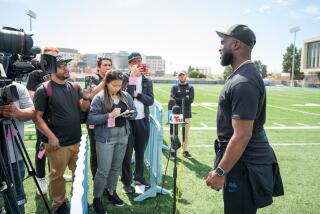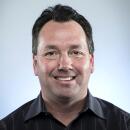Big man in the ravine
Fifty years ago, the biggest man inside Los Angeles’ biggest new landmark was 6-foot-7, 255-pound Frank Howard, the National League rookie of the year in 1960 who helped break in Dodger Stadium by slugging 31 home runs, batting .296 and driving in 119 runs.
Howard, 75, resides in Northern Virginia and stays informed about major Dodgers news, such as Magic Johnson being part of the new ownership group and Clayton Kershaw winning last year’s NL Cy Young Award, only on a limited basis.
“I make a trip once a week down to the gas station to pick up a paper, just to make sure the rest of the world is still OK,” Howard said.
Added Howard: “Didn’t the Dodgers just change hands?” and “I think I scouted [Kershaw] a few years ago. He looked good.”
Howard, who hit 382 home runs, retired from baseball three years ago after a 50-year ride that he finished as a scout for the New York Yankees. He will not attend a reunion Monday of Dodgers legends at Dodger Stadium, which is celebrating its 50th anniversary, because of previous commitments. But he remembers well the opening of the stadium.
--
What jumps to your mind when you think of Dodger Stadium’s early years?
“It’s hard to believe that’s the third-oldest baseball stadium now. All I remember is walking into the ballpark and it was so antiseptic you could eat off the floors. It was obvious then that it was time for baseball to come to the West Coast, and with the Dodgers, Los Angeles gained in Carl Furillo, Pee Wee Reese, Carl Erskine, Jim Gilliam and Duke Snider a close-knit family. We had 11 farm clubs at the time, so getting up there and staying after all the instruction at winter ball in Latin America and Dodgertown was the final step of a great baseball education.”
--
On the field, how good were those Dodgers?
“We were expected to win our league every year. We were more of a pitching-dominated team then with [Sandy] Koufax, [Don] Drysdale, [Johnny] Podres, [Norm] Sherry. That stadium was built for that strength of our organization, and the alleys were 10 feet deeper than they were for the [Steve] Garvey-[Ron] Cey-[Dusty] Baker Dodgers of the ‘70s.”
--
Was it difficult for you to reach the seats?
“No, not really. My friends Tommy Davis and Willie Davis had learned that the rotation and location of the fastball dictated what you did; they could hit chalkline to chalkline. Nobody did it better than Tommy.”
--
What can you tell me about 1962?
“The ’62 team was the best ballclub we had while I was there, but we lost Koufax at the break with circulatory problems, and lost a three-game playoff to the great Giants of [Willie] Mays and [Willie] McCovey. There’d have been no playoff if we had Koufax all year. We proved that in ’63. We made it to the World Series, and even though the oddsmakers favored the Yankees, with a rotation of Koufax-Drysdale-Podres, we swept ‘em.”
--
Your home run in Game 4 of that ’63 Series in Dodger Stadium off Whitey Ford was huge. It gave you the lead in a game the Dodgers won, 2-1. What do you recall of that moment?
“I hit a fastball off him in the first game off the [Yankee Stadium] monuments. So I suspected he’d give me a curveball. I was sitting on it. You don’t think about the significance of it at the time, you’re just focused on the idea you have to put up numbers to win. I don’t dwell on the past. There’s nothing more passe than an old ex-jock, a 70-year-old, talking about how good he was. You’re a mere mortal. The great Pee Wee Reese said it best: ‘If you have talent, you don’t have to tell people.’ ”
--
What do you think of today’s sluggers such as Albert Pujols, Prince Fielder, Adam Dunn?
“It’s unbelievable what these young guys can do. I heard quite often, ‘They don’t make ‘em like they used to,’ and that’s right -- they make ‘em bigger, faster and stronger. And a hell of a lot smarter. These guys are marvelous talents.”
--
What changed since your day was the influence of performance-enhancing drugs in the game. What have you thought of all this?
“We’ve always had to answer critics. In the ‘50s and ‘60s, there were heavy drinkers. In the ‘70s, drug use was a problem. Through education and awareness, baseball cleaned it up. That’s happening again after we got into the juice. The guys in recent years are bigger, stronger, they’re doing year-round conditioning. I was in real estate and a consultant for Jim Beam brands in my off-season. It behooves these guys to prepare year round, and it’s resulted in great players. When I saw Mark McGwire hit a baseball -- and, remember, I saw Willie Stargell, Willie McCovey, Hank Aaron, Harmon Killebrew -- McGwire could hit it harder than any of them. I don’t know about his living habits, but I don’t care what anyone says, you hit 70 homers, you’re gifted.”
--
Do you think these records assisted by steroids should have an asterisk?
“I’m not the commissioner. I’m not informed enough to know.”
--
Would you have juiced?
“Who’s to say? Put it this way: If it’s legal, and I’m hitting 20 homers, and my agent says, ‘Don’t you have 10 more homers in you? Try this ... .’ If it’s going to jump you from $2 million to $10 million a year, and if it’s legal, or not banned, I’d consider it.”
--
More to Read
Are you a true-blue fan?
Get our Dodgers Dugout newsletter for insights, news and much more.
You may occasionally receive promotional content from the Los Angeles Times.










